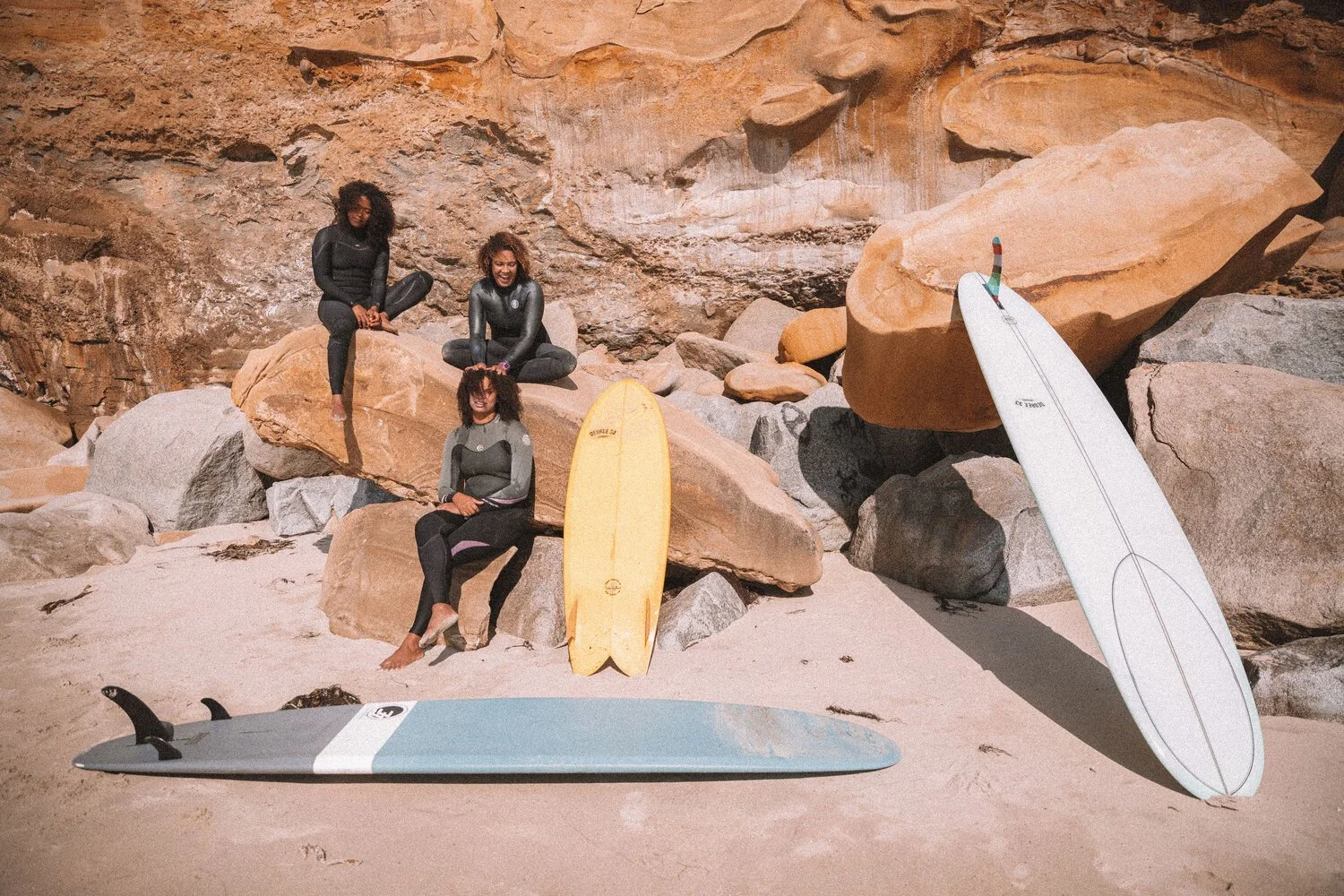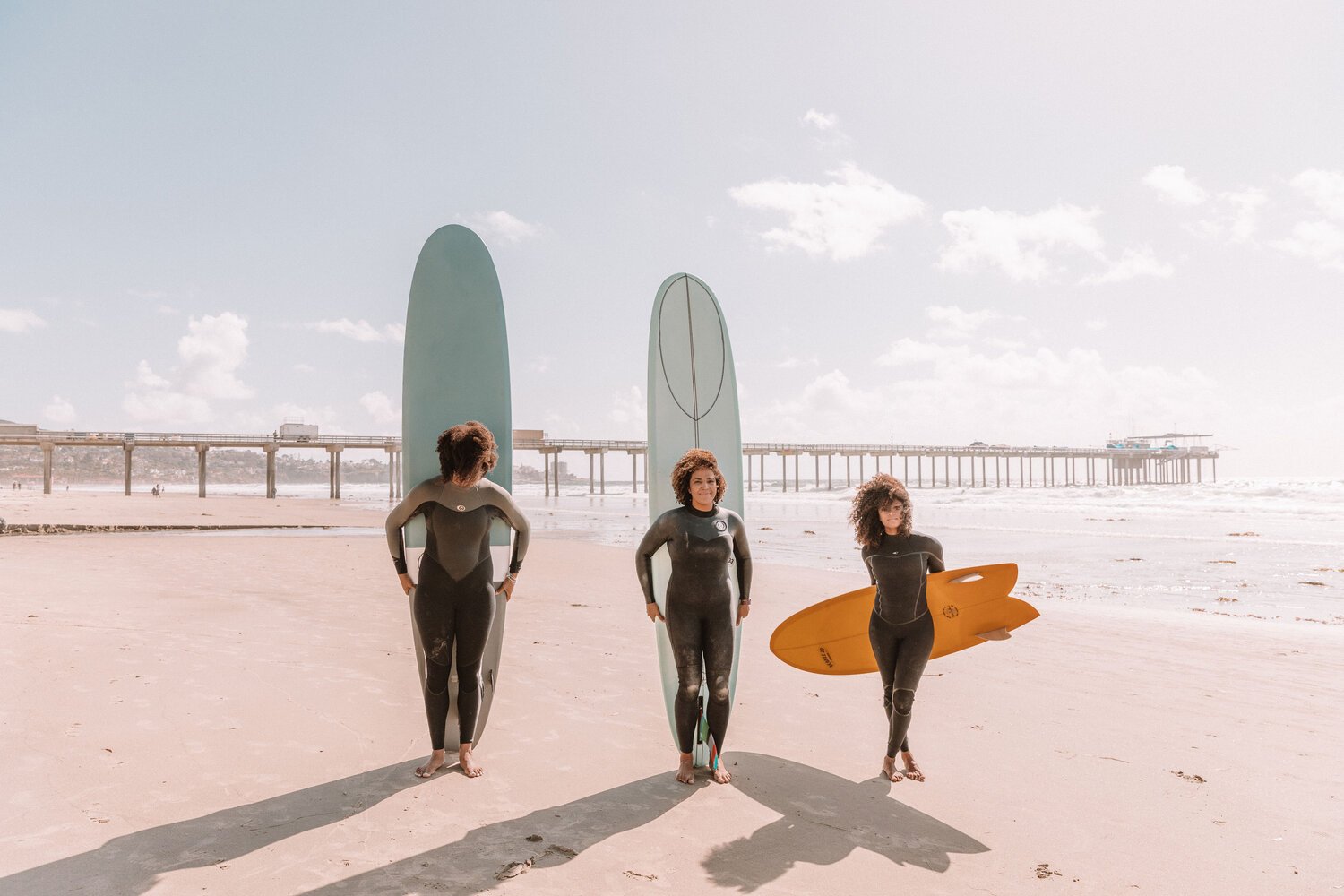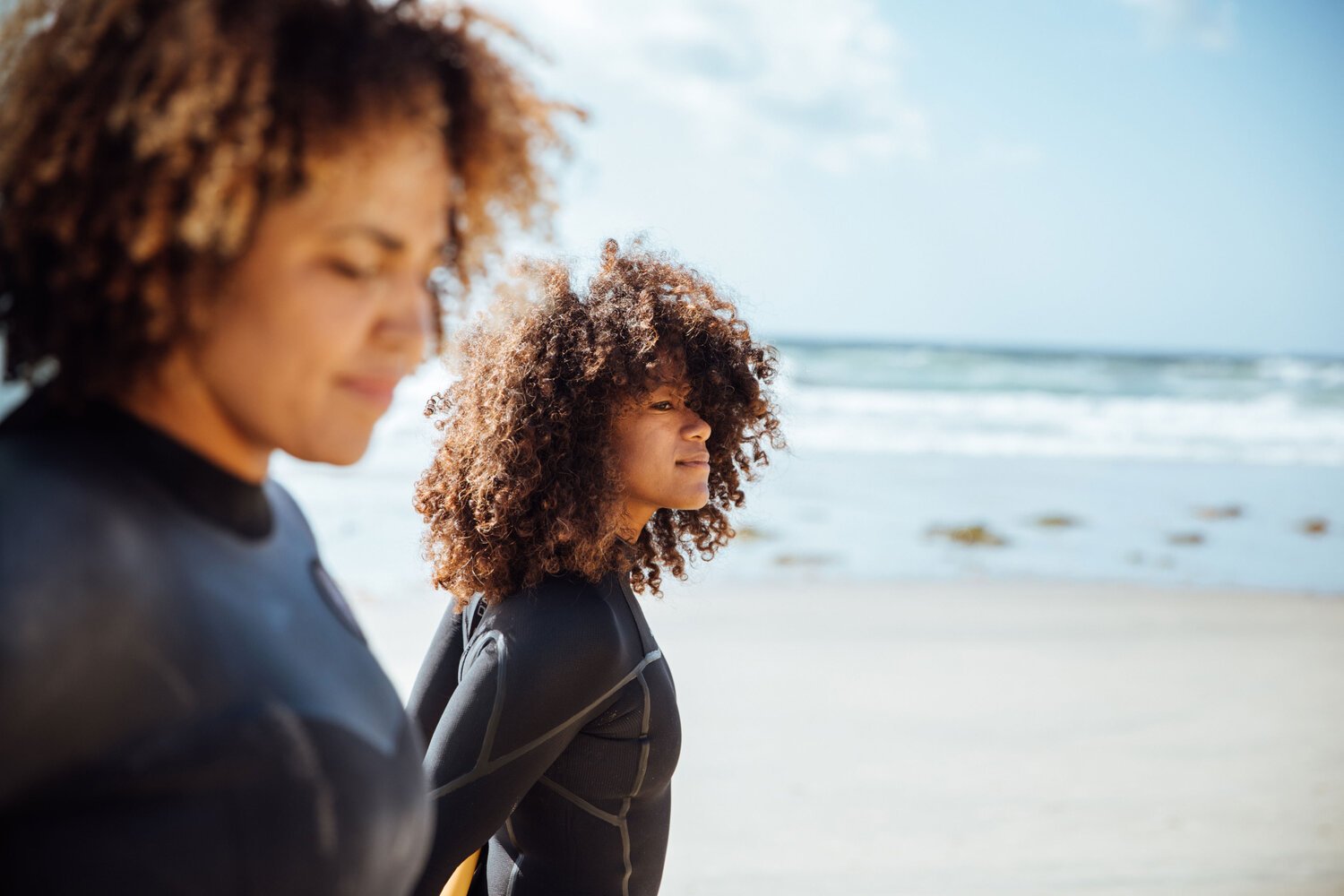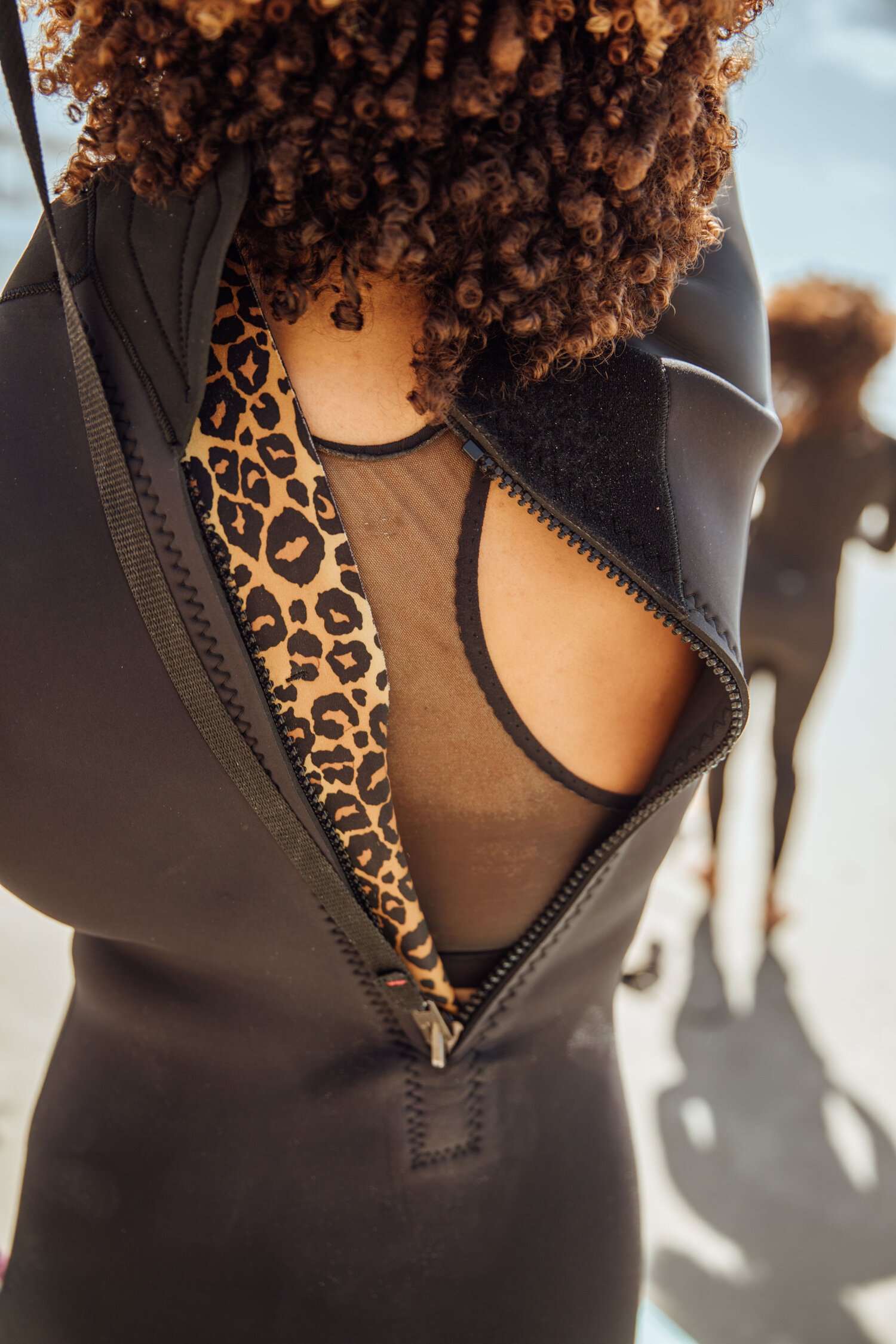Desegregate Surfing
WELCOME THE WAVE-SLIDING WOMEN OF TEXTURED WAVES
Photos by Kat Carney // @katcarney
Interview by Justin “Scrappers” Morrison // @scrappers
Featuring Textured Waves Community Members // @texturedwaves
“My beach! My chicks! My waves! Go home! Go home!”
-Surf Punks, from their 1977 tape My Beach.
Growing up as a “Valley Kid” in Burbank, California, I so desperately wanted to be a surfer, so I dressed the part. Using white foamy mousse, I styled my blond hair into a curling wave. Back to school clothes came from Val Surf: Jimmy Z velcro pants, Hobie surfasaurus T-shirts, and T&C stickers for my Trapper Keeper. I watched North Shore countless times to learn the walk and talk. The secret surfer gang sign became all mine. “Shaka, broh-ther.” The soundtrack for my whole vibe came from a tape by the Surf Punks. They rhymed “tubes” with “boobs” and they taught me surf culture. When I finally got a surfboard the reality of my fake surfy identity melted like a sand castle against the waves.
On the elementary school playground, I could walk and talk like a surfer, but in the water I was 100 percent pure, unrefined kook. It wasn’t until I grew out of my fake surfer phase and moved north to Oregon that I actually began surfing and seeing the truth about surf culture. The dominant narrative of checking out teenage girls, chugging brews, and having radical tube rides was sold to me from the surf industry by old white men. The truth I found out in Oregon’s cold water was about picking berries on the hike in, the magic of Canadian wool, and that we all look the same in black hooded wetsuits. Surfing strips me of all the decorative nonsense I surround myself with—so I can stand up solid with pure intentions and ride waves of natural freedom.
Surf culture as it was sold to me was not the truth. Culture is fluid like the water it grows around; it’s not up to an industry dominated by old white men to define. Culture is up to each of us to define.
People of color in the States face more obstacles than a white boy from the Valley like me, but in finding our separate paths to the water, we found culture. The women of Textured Waves are redefining surf culture. Their perspective isn’t what we see printed in surf magazines or sold in surf shops, but it’s a truth we should all welcome and encourage if we want to elevate the surf culture conversation. I asked Textured Waves a couple questions and realized very quickly that we might come from different backgrounds, but we all get in the water for the same reasons.
WHY DO YOU SURF?
Danielle Black Lyons // I feel deeply connected to the sea. After dropping my son at school, riding waves is how I start my days. It gives me creative inspiration and sets the mood for the day ahead.
Chelsea Woody // Surfing is my baptism. I have a stressful day job working in healthcare and it’s so important for me to plunge into the ocean and wash off all the trauma and stress of my day.
Martina Duran // Surfing is my grounding activity. It is how I release the negative, but also how I release the ego. It brings me back to center my thoughts for the remainder of the day.
Gigi Lucas // I surf because it reconnects me to a place that grounds me and frees my mind.
HOW HAS SURFING TRANSFORMED YOU?
Danielle- Surfing has molded me into this shiny version of myself that I didn’t know existed. I am more tolerant, kind, and creative when I start my days with a surf. It’s a noticeable difference when I haven’t surfed. It’s like how some people rely on that morning cup of coffee to get them through their day. Surfing is my cup of coffee!
Chelsea // Surfing has allowed me to see the world through a different lens and express myself in various creative ways. The ocean has taught me so many lessons in patience, perseverance, persistence, and self acceptance.
Martina // As someone who suffered a seven-year battle with depression, surfing was the activity that pulled me out of the dark. It was at times the only thing that gave me light. The ocean has taught me the purest form of acceptance. It allows all forms of energy to roll through her without changing its permanent mold. I used to think that the ocean “washed away” my problems, but now I know she has taught me to accept them and let the world roll through me without changing who I am. I keep true to myself because the ocean has shown me that for every storm I may have to weather, there will be twice as many sunsets. And accepting both equally is the true definition of grace, power, beauty, and peace.
Gigi // I call surfing my type A personality therapy. Surfing is constantly teaching me to surrender and remain present, which is completely contradictory to my innate behavior.
HOW DID YOU GET INTO IT?
Danielle // I have always been a waterwoman growing up in northern California. It was a natural next step in my journey when I was visiting a friend in Hawai’i and she let me borrow her longboard. Everything just clicked and I knew I was meant to ride waves.
Chelsea // I haven’t been surfing for a very long time—I only started about four years ago at the age of 30. My husband and I were on a year and a half sabbatical from work and one of my goals was to learn to surf. We planted ourselves in Indonesia for a couple of months and taught ourselves to surf.
Martina // I took my first lesson while spending a semester in Costa Rica for a study abroad program in college many years ago. I further honed my skills while living in Florida and continue to grow in my surfing journey here in Hawai’i.
Gigi // Surfing has always been on my “learn-to-do” list. So when the opportunity presented itself to move to a locale where I could literally design my day around swells and tides, I jumped on it.
WHY DO WE NOT SEE MANY BLACK SURFERS IN SURF CULTURE?
Textured Waves / Culturally, in America it’s not a sport that has been nourished in the African American community. There have been a select few influential African American surfers, but somehow their stories seem to get overlooked. Surfing is a sport that is passed down through generational exposure—that coupled with our limited access to water that dates back all the way to slavery times. There are key points in history that held black folks back from their potential as waterwomen and men such as Jim Crow laws, the segregated pools and beaches of the 60s, and specifically for African American women, societal pressures imposed on us to maintain unrealistic standards of beauty. As time goes on, oppression is adopted as culture and we find generational gaps in aquatic arenas. African American women have an especially complicated relationship with water due to fear of repercussions for their hair, another type of eurocentric bondage to unpack.
WHAT OBSTACLES DO YOU THINK POC FACE WHEN ENTERING SURF CULTURE?
TW / There are still no professional African Americans on the World Surf League or professional circuits, and it’s important that we analyze what those barriers might be. Lack of representation and feelings of otherness can make it hard to enter surf culture. Surfing professionally still requires somewhat of a leisurely lifestyle, and if your folks aren’t financially able to afford to send you into the competitive world then that makes it difficult. There’s a lack of sponsorship to infiltrate and influence change in the mainstream surf industry. Also, entering a surf culture that for nearly 70 years remained so tightly-knit is intimidating. Localism at surf spots is hard to penetrate, especially when much of the rhetoric behind localism is reminiscent of that of the Jim Crow era mentality. For example: “If you don’t live here, don’t surf here.”
In American coastal towns, there is often a lack of diversity. To be good at surfing, daily exposure is necessary. So people of color tend to stick out like a sore thumb and that comes with a lot of curiosity. People are mostly kind and welcoming once they’ve seen you a few times, but we still get a lot of long looks in the lineup. Some people have never seen a black surfer and there is a sense of having to be an ambassador of your people and proving that you deserve to be there.
Wave riding is indigenous in its roots; Hawaiians brought surfing to the masses. White Americans took this sport of kings and made it mainstream.
A great majority of people still associate surfing as being for white males only. This is reinforced due to the saturation of surf films, advertisements and photography focusing on that culture and dominating the media. Textured Waves’ mission is to smash that dated narrative and turn it on its head.
WHAT’S THE NARRATIVE TEXTURED WAVES WOULD LOVE TO HEAR TOLD BY FUTURE GENERATIONS?
TW / We hope future generations feel more comfortable in outdoor and aquatic spaces and don’t question their place in the lineup. We would love to see groms ripping on the professional circuits, perhaps the first Serena Williams of surfing.
WHAT CAN ALL SURFERS DO TO HELP CHANGE THE DOMINANT NARRATIVE?
TW / As far as journalism goes, it’s important that surf trades, organizations, and media outlets do their research. So much of the attention focused on black surfing is negative and clickbait material that contributes to the stereotypes that many of us are working hard to tear down.
We can’t change anything if we aren’t allowed in the door. Every person can be a bit more kind when they see a new face in the lineup and try and have some empathy. After all, it is a privilege to grow up feeling comfortable in the ocean.
The ocean does not belong to one person or one group.





